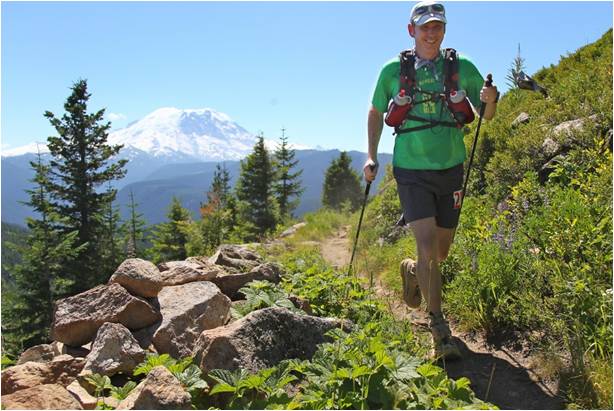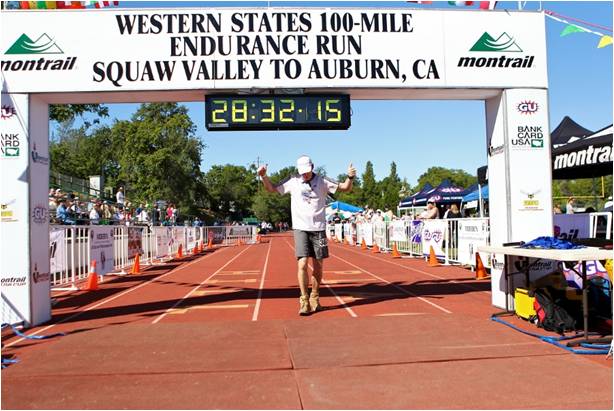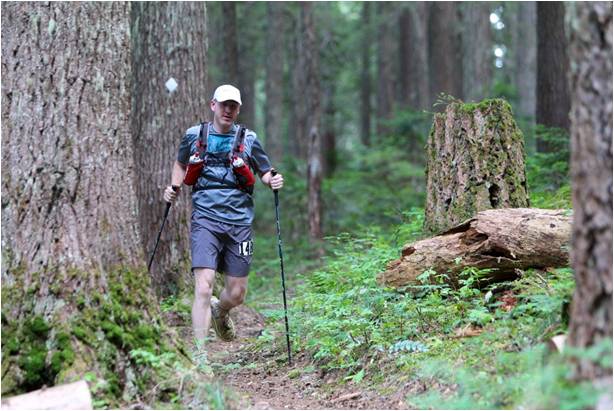Running an ultramarathon is a unique experience and in many ways is very much different than the mainstream running that many of us have grown accustomed to. I have always marveled at ultramarathoners who run some of the most difficult races and push themselves to limits many of us would not even fathom. In his book Born to Run author Christopher McDougal provides us a glimpse into their fascinating world and leaves you wanting to see inside the minds of these amazing athletes.
For me today is the day as Ultramarathoner Will Thomas of North Bend, WA provides some insights into what it means to be an ultra runner. I know Will through a mutual friend from my time living in North Bend. All I have to say about Will is that he has my utmost respect. I have long been interested in running the White River 50 mile endurance race but have never quite found the courage to follow through with it. Will has not only found the courage to do it but he has found it more than once. In Will’s world, the White River 50 is mere child’s play compared to some of the monsters he has tackled.
Will was nice enough to grant Runnersgoal.com an interview where he has provided a valuable look inside of the world of ultra running.
Which runners inspire you and why?
I am inspired by runners that push the boundaries of endurance to change what we view as possible. I love seeing runners travel longer and faster to new and remote locations. Leor Pantilat and Jared Campbell are great examples of this.
During the wet San Francisco winters Leor can be found winning 50k and 50 mile trail races weekend after weekend, usually breaking his own course records in the process; but once the snow melts out of the high Sierra Mountains, Leor gives up his racing to head out each weekend on what he terms, “adventure running”. This usually consists of exploring 30-50 miles of far off high reaching mountain peaks; some of this happens on trails, some off trail. All while taking hundreds of breathtaking photos and he’s back into civilization in time for dinner. He chronicles each of these awesome inspiring runs on his blog (click here).
I have never seen someone enjoy suffering as much as Jared Campbell. He will find the hardest challenges available and then somehow find a way to make them even more difficult. For instance last year when he completed what he termed, “The Summer Slog Challenge”. This started off with completing the Barkley Marathons (a 100 mile trail race with 59,000 feet of climbing within the 60 hour cut-off). There have only been 14 people to ever complete this race. He then went on to finish the Hardrock 100 (a 100 mile trail race with 34,000 feet of climbing which is all at oxygen sucking altitudes of that 8,000 – 14,000 feet above sea level). This was his 7th all-time finish there. He then moved on to complete the Nolans 14 (a 100 mile run with no official trails that climbs 45,000 feet over fourteen 14,000 foot peaks in Colorado within a 60 hour window). There have only been 7 people to accomplish this task. To close out the summer he completed the Wasatch 100 (which consists of 28,000 feet of climbing where he took 6th place, then followed it up his own torture chamber that he made up in his backyard Wasatch mountain range which he named the Millcreek 100 (this consist of 40,000 feet of climbing over 100 miles), which he accomplished in 34 hours. That is a summer of 500 of the most challenging miles with over 205,000 feet of climbing. That is the equivalent of climbing from base camp to the summit of Everest and back down 17 times. Jared keeps a blog of all his epic challenges here (click here).
I also enjoy seeing everyday working fathers and busy mothers successfully balance work and family while succeeding in the sport of ultrarunning.
What inspired you to become an ultramarathoner?
Back in the fall of 2006 I followed along as two amazing athletes Sam Thompson and Dean Karnazes both completed 50 marathons in 50 states in 50 days. It was amazing watching them knock out marathon after marathon every day, but that still wasn’t technically in the realm of ultrarunning.
Skipping forward to the summer of 2007, I watched in amazement as a new sports drink kicked off their first promotional efforts by installing a treadmill above Times Square and having Dean Karnazes attempt to set a new world record for covering the most miles on a treadmill in 24 hours.
Dean did not come close to the 153.76 mile record that day as he came up just shy of 5 marathons. Being both ignorant and fascinated with what I witnessed, I quickly did the math and realized Dean averaged a marathon about every 5 hours. Being both a mid-pack 4 hour marathon runner, this became something I thought I might actually be good at. It’s amazing how we forget the laws of physics and just as we can’t use our 5k pace as our marathon pace, the same principle applies to ultramarathons.
I do not think I ever tried the sports drink, but the “Dean Karnazes” marketing worked for me as I went right out and bought his book, Ultramarathon Man. As I read his fascinating stories of discovery ultrarunning, I was hooked and wanted to give it a try.
How do you prepare for an ultramarathon race?
Definitely not how I trained for my first ultra! Dean Karnazes came to Seattle on the North Face Endurance Challenge in the fall of 2007 where they offered a 50k and 50 mile race. I never was one for doing the whole 3-4 month marathon training plans. I would usually head out for a 15 mile run about 2 weeks prior to a marathon and use that to gauge what my race day should be like.
I figured a 50k would be very similar and that I should just tack on an extra hour for the extra 5 miles and maybe another hour for being on hills and trails instead of the road. This would have me finishing around 6 hours. Well… 31.2 miles and 10,000 feet of vertical climbing later I crossed the finishing line in 8 hours and 45 minutes vowing to never do that again.
I suffered severe quad and calf cramping and even found myself getting passed by a limping man who had sprained his ankle
I have since learned a few key training tips for preparing for an ultramarathon:
- Train on terrain similar to the race course.
- Run smart – You may run every step of a marathon, but that probably is not the smartest thing in an ultra. The key is keeping your heart rate at a sustainable rate.
- Back-to-back long runs – You do not need to up your mileage from a marathon training schedule, but instead try doing a long run, then following that up the next day with another long run. Learning to run on tired legs will come in handy.
- Use races as long runs – Use marathons as a supported long run and 50k races 2 to 3 weeks apart to train for your first 50 miler.
How do you manage the responsibilities of life and successfully find time to train for an ultramarathon?
This is probably the hardest part of training for an ultra. As any marathon runner knows there is a big time commitment required to successfully train for your “A” race. With a demanding full-time job, working spouse, young children and community involvement; time is limited. My training needs to have as close to zero visibility to my family as possible. 90% of my runs are completed in the early hours of the morning under headlamp. My alarm will go off as early as 3:30am some mornings in order to squeeze that long run in before work or to get back before the kids wake up on the weekend. You learn to find solace in those early hours and any time-wasting habits are kicked out the window.
Which is your favorite ultramarathon and why?
The more challenging the better, the steeper the better, the more off the beaten path the better, the more scenic the better. Out of the 25 or so ultras I have completed I would say the Gorge Waterfall 50k has a lot of those attributes and has brought me back for more. About 6-7 of the ultras I have completed had a lottery registration as there were more people wanting to compete then the race had permits for. This speaks volumes to those races.
There are still plenty of races on my “bucket list” that could easily become my favorite if/when I get to run them. I have qualified and entered the Hardrock 100 mile lottery for the 3rd year in a row now. Also there are two races in Europe that I hope to tackle in the coming years including the Ultra-Trail Du Mont-Blanc (UTMB) and the Tor Des Geants.

What is the craziest thing you have ever seen during an Ultramarathon?
Hallucinations are common among the sleep deprived miles late in a 100 mile race. I have sat down and talked with a water snake for 5 minutes while filtering water from a stream in the middle of the night in Mt. Rainier National Park and I have also broke up a herd of giant sea turtles high up in the Wasatch mountain range. It is crazy what the mind thinks up when running low on sleep and calories.
How difficult is it to run a 100 mile race?
Not as difficult as you would think just to finish within the time cut-offs. Anyone with determination can complete a “hundred”. To be competitive, then that is another story.
They say the first 50 miles are all physical and the last 50 miles are all mental. The legs will get you half way there, it is up to the brain and heart to get you through the final 50 miles. It is important to break the race down into small achievable sections. I usually only focus on getting from one aid station to the next (usually 5-10 miles).
The more intel you have on the course the better off you will be on race day as well. Run as much of the course as you can, study the maps, know when and where the hills are, know what the temperature will be like. If you can visualize success, then you will set yourself up for a great race. If you put in the months of training and show up on race day healthy and injury-free you will be able to complete a “hundred”.
I would recommend getting a couple 50 mile or 100k races under your belt first and 1 or 2 all-night runs and then you will have done everything you can to prepare yourself for success.

(Will Thomas 2013 Cascade Crest 100 mile race Mile 85. Photo by: Glenn Tachiyama)
What is one thing about ultramarathon running that traditional runners probably do not know?
Chaffing, caffeine and pacers. When you are out there all day and all night in all kinds of weather, things start to rub and chaffing in the most random spots can stop you in your tracks. Ultrarunners are aware of this and are usually well prepped with the right clothes and right lubricants to get through the stickiest of situations.
Caffeine is a tool that most runners take advantage of to get through the endless night and next day of a 100 mile race. It can be that perfect boost to put that pep back in your step and get the blood flowing again.
Also, most 100 mile races allow the runners to have a pacer join them for the last 50 miles of the race. Race directors know runners probably would not make the best decisions after being on our feet all day, so they allow us to have a fresh runner alongside us to make sure we stay on course and get from aid station to aid station. Volunteering to be a pacer is a great way to experience what the last 50 miles of a hundred mile race feels like.
Which advice would you give someone who is apprehensive about trying an ultramarathon?
Ultramarathons come in all shapes and sizes. Find one that suits your strengths. There are numerous ultras all around. You do not have to bushwhack over mountain peaks and ford across icy streams to run an ultra. Find that one that has terrain you are used to and that you like running on. If you like roads, find a road 50k. If you like soft gravel paths, then find a rails to trails 50k. If you do like hiking through the mountains, then sure go find that 50k that weaves through your favorite forest.
Another great way to break into the ultra-scene is to sign up for a timed event. These are usually 6, 12 or 24 hour continous runs. You can’t go wrong with a race that does not have a set distance finish line. These races are ran on loop courses that could be as small as a track field but usually range from a 1-5 mile loop. This will remove all pressure to run fast and beat the clock. You can take your time and walk as much as you need. Technically you only need to rack up 26.3 miles to be an official ultrarunner. If you have 6, 12 or even 24 hours do cover that distance, then the pressure is removed from you. If you get to 26.3 miles and there is still time left you can keep moving for as long as you want or if it is not your day and you only knock of 15 miles, you still finish. It’s a win-win situation and a great low pressure way to move up to the ultra-distance.

What are some of the mental struggles that you’ve had during an ultramarathon?
Fatigue and sleep deprivation are the mental monsters that chase me down in a 100 mile race. It is never a matter of beating them to the finish line. I always know they will catch me and I just have to be mentally prepared when they attack. I am not a caffeine guy, so I use music to help my mind speed through the long dark hours of the night. This means that I need to use my music sparingly and save it for the times that I need a pick me up. From time to time, the mental monsters win out and I just lay down on the trail and close my eyes for a couple minutes. It is amazing how refreshing a 5 minute nap can be.
What is the longest training run you’ve ever run?
I have had training runs that last as long as 95 miles and 40 hours before. I did this run a few months before attempting my first 100 mile race. I wanted the confidence that I could cover the distance, but not have the pressure of completing it within a specified time. Usually, my long training runs will be between 15- 40 miles, but I also use other ultra-races to help build up for my longest race of the season.

How many miles a week/month should someone be running for a 100 mile race?
I don’t think there is a set answer. I have been able to successful train for a hundred with as little as 25 miles per week. These 25 miles were tailored very specific to mimic course conditions. There were no wasted miles just for the sake of running more miles. Of course, the definition for “successful” for this race was to complete it within the time limits.
Usually in my last training cycle before a 100 miler I will average around 40-50 miles a week for about 4 to 5 weeks. I consider myself a low mileage runner and I try not to run just for the sake of running. Because the races that I like to do are mountainous with lots of climbing and descending I usually measure my runs by elevation gained instead of by distance or time.
It seems to be competitive, the top runners are usually averaging 80-120 miles a week and that could include upwards of 30,000+ feet of climbing depending on the race they are training for.

Do you have any “war” stories that you would like to share that occurred during a training run or ultra race?
The mind does a great job of blocking out the painful memories and after a while we usually look back and all we remember is how fun and enjoyable the adventure was. That being said, some things I will never forget like: spooking a bear, spraining my ankle 75 miles from my car, running all day, but not being able to eat or drink any calories the entire time, stopping to get a rock out of my shoe only to realize it was my toenail that had fallen off and of course I will never forget getting super chaffed between my legs and then accidentally using an alcohol wipe to clean up. In the end, it’s always been worth the adventure.


Wow I must confess you make some very trnnchaet points.